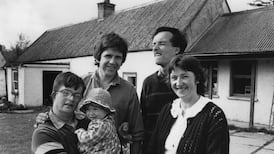Helen McKendry often stands outside the derelict house in west Belfast where her mother, Jean McConville, was last seen alive. An alleged informer, she was "interrogated" there by the IRA. She had 10 children but she was still killed. They didn't even bother returning her body.
"I don't know where they buried my mother," says Helen. "They could have taken her somewhere else or she could be lying under that house in Beechmount. I can't stop visiting the house . . . I want to pull it down, brick by brick, with my bare hands, to make sure she's not there. I look at the other houses nearby and think `Did somebody not hear her crying for help? Did they just turn up their televisions to drown her screams'?"
After 27 years of denials, the IRA finally came clean on Monday. It admitted abducting, killing and secretly burying Jean McConville and eight others. It is to release details of the location of their graves over coming days.
The RUC will then move in with earth-scanning equipment, similar to that used by Gloucestershire police at the Wests' home in Cromwell Street.
"The waiting is sheer hell," says Helen. "All the memories are flooding back. I haven't slept all week." The IRA statement claimed her mother had admitted being an informer. "God knows what they did to get her to confess that. What mother of 10 has time to be an informer? What would she have known to pass on to the British - recipes?"
It was Christmas 1972 when eight masked IRA men and four women abducted Jean at gunpoint in front of her screaming children. Her "crime" had been to cradle a British soldier in her arms as he lay dying outside her home in Divis Flats.
Her husband had just died of cancer and she was recovering from a nervous breakdown when she was abducted. Helen, who was 15, didn't contact the police. "I thought the IRA still had her and that would endanger her life." Five weeks later, a man called to the house with Jean's purse and rings. He said nothing. Later, the IRA spread rumours that she had deserted her children for a British soldier.
Helen struggled to raise her brothers and sisters but eventually they were all taken into care. "We were separated and we gradually drifted apart."
They gathered this week for the first time in 26 years to arrange their mother's funeral. "It was good to meet up but we will never be a proper family again." Helen is angry that any information she gained over the years about her mother's fate came from individual republicans acting unofficially.
"The IRA leadership gave us nothing. We were 10 wee children, for God's sake! Did they have no compassion in their hearts?" She believes that, after all these years, the IRA has admitted the deaths in an attempt to ease the pressure over decommissioning.
"They thought if they gave on this one, they wouldn't be hammered so hard on handing in weapons. The corpses of our relatives became political pawns."
Helen's mother will be buried in the family grave near the republican plot in Milltown Cemetery. The inscription on the headstone will read: "Jean McConville disappeared and subsequently murdered by the Provisional IRA in 1972".
"When the tourists visit the IRA graves, I want them to see my mother's and ask questions about what happened her. The disappeared were part of Irish history whether the Provos like it or not. I don't want them ever forgotten."
On Mothers' Day, Margaret McKinney accompanied a friend to the grave of her son, who was killed in the Troubles. "I thought `Isn't she lucky, having a grave to visit?' And then I realised how awful it was to think a mother who lost her son lucky just because she had a grave."
Margaret is hoping to have a grave to visit soon herself. Her son Brian - Bru to his friends - was one of the disappeared mentioned in the IRA statement. He was 22 when he was abducted on his way to work in Andersonstown, west Belfast, on May 25th, 1978.
His best friend, John "Bugsy" McClory, was kidnapped on the same day. He was 18. They were both involved in petty crime. In its statement the IRA claimed they used one of its weapons in a robbery. It was an amateurish affair. They never fired a shot; they were far from hardened criminals, spending most of their time drinking and playing cards under street lamps.
Margaret is delighted she will finally be able to lay Bru to rest. "I can sleep at night now. I'm 67 and his daddy is 73. How could we have gone to our graves in peace without giving our son a Christian burial?"
"It was bad enough that they [IRA] killed my son, but why did they hide it? They would have saved us so much suffering if they had been honest." Initially, the IRA said Bru was in England. Margaret gathered the fare and packed her suitcase, ready to go to her son when the phone call came. It never did.
When it became obvious the Provisionals were involved, Billy McKinney withdrew his life savings of £300 and offered it in exchange for his son. He was told the IRA knew nothing about Bru.
Although the IRA has now finally admitted the deaths, it is still refusing to divulge any further details. According to local speculation, the two boys were taken to a flat in Lenadoon for "interrogation".
Fearing they would be killed, Bugsy jumped out the window and fell three storeys. He was injured but managed to get up and run. His captors shot him in the back. Bru was then killed because he was a witness.
"I don't know if that's true but I need to find out," says Margaret. "Sinn Fein and the IRA always demand the full facts when the British army or RUC does something wrong. So they should be able to offer the same to me."
The most common theory in west Belfast is that Bru and Bugsy are buried in a local housing estate which was under construction at the time. "I hope Bru is under waste ground," says Margaret. "I once heard he was under a community centre and that wouldn't be too bad either.
"But I would hate it if he was under a house. I'd feel awful if some family had to have their home demolished to find him. And yet who could live in a house with a body buried below? If he is under a house, I'll go and see the family and apologise."
Bugsy's mother, Mary McClory, a widow, is recovering from a stroke. She sits by the phone all day waiting for news. She won't be able to visit the location herself but she has asked her local priest to be present when the digging starts. "I wouldn't want it to be only workmen and police there when he was found."
Unlike the McKinneys and the McKendrys, Mary McClory will bring her son's coffin home before it goes to the church. "He disappeared on his way to work. He never came back. I want to bring him home one last time."
Margaret McKinney will be content visiting Bru's grave. "There will be a photo of him on the headstone and an eternal flame so he never gets lonely. I will have nice wee flowers there - bright colours, nothing gloomy. And I'll visit him every day. I'll be able to talk to him, to scold him for getting into trouble in the first place."











